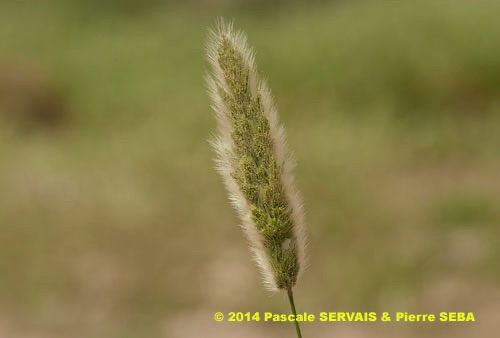
Polypogon monspeliensis (L.) Desf.
Fam. : Poaceae
© Pascale SERVAIS & Pierre SEBA, 2018. Tilo Botanica: Flore de Tilos et du Dodécanèse / Flora of Tilos and of the Dodecanese
English translation by Brenda Bradbury, Howard Bradbury and Stéphane Léonard
Plante herbacée, hermaphrodite, stolonifère, en touffe érigée, à tiges noueuses, cylindriques, non ramifiées, glabres, rugueuses au sommet, de 1,5 à 3 mm de diamètre.
Feuilles alternes, simples, linéaires, entières, embrassantes, glabres, rugueuses sur les 2 faces, de 7 à 20 cm de long, de 4 à 8 mm de large, avec de minuscules dents rudes sur les bords. Ligules membraneuses, oblongues, aiguës, de 3 à 10 mm de long.
Fleurs jaunâtres, à épis réunis en panicules spiciformes, cylindriques, denses, de 3 à 12 cm de long, blanchâtres puis roussâtres. Épillets de 2 à 3 mm de long, uniflores, à pédicelle articulé. Glumes jaunâtres, égales, vertes au sommet, velues sur toute leur longueur, très ciliées, entières ou faiblement échancrées, longuement aristées près du sommet. Arêtes soyeuses, droites, ayant 3 à 4 fois la longueur des glumes. Ovaire supère.
Fruits, caryopses bruns.
___________________________
Plant herbaceous, hermaphrodite, stoloniferous, in an erect tuft. Stems nodose, cylindrical, unbranched, glabrous, rough at the top, from 1.5 to 3 mm in diameter.
Leaves alternate, simple, linear, entire, clasping, glabrous, rough on the 2 faces, from 7 to 20 cm long, from 4 to 8 mm across, with tiny, hard teeth on edges. Ligules membranous, oblong, acute, from 3 to 10 mm long.
Flowers yellowish, with spikes joined together in panicles spiciform, cylindrical, dense, from 3 to 12 cm long, whitish then reddish. Spikelets from 2 to 3 mm long, uniflorous, with jointed pedicel. Glumes yellowish, equal, green at the top, very hairy over all their length, very ciliate, entire or slightly indented, lengthily aristate close to the top. Awns silky, straight, 3 to 4 times as long as the glumes. Ovary superior.
Fruits, brown caryopsis.
Descripteurs / Identifying features
1
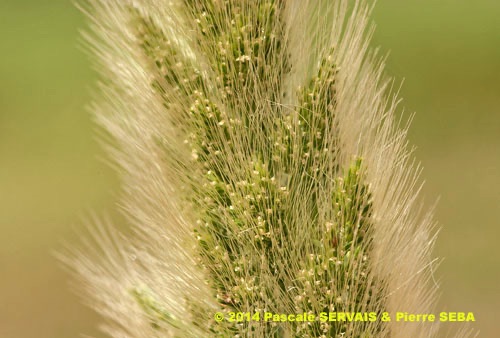
2
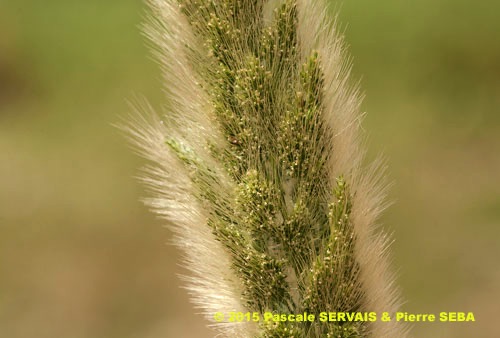
3
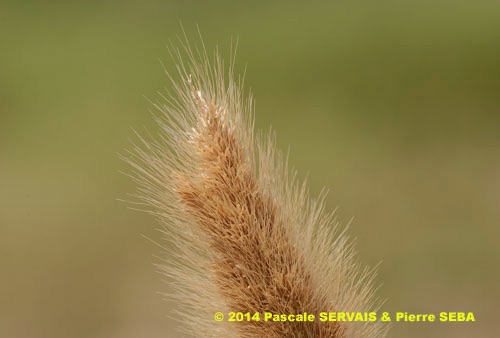
4
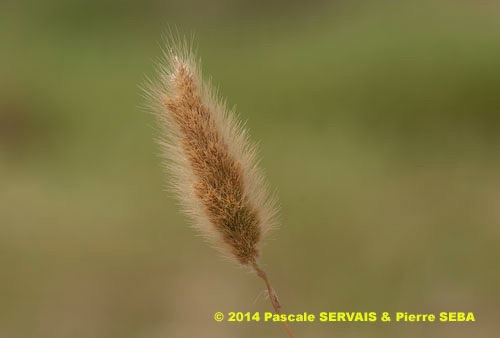
5
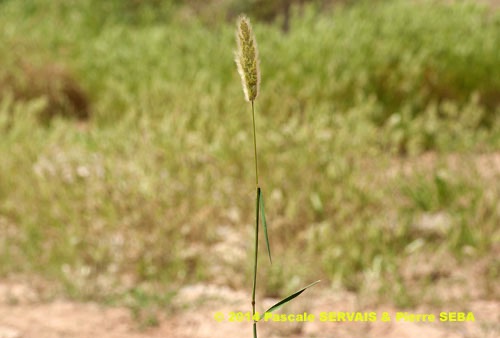
6
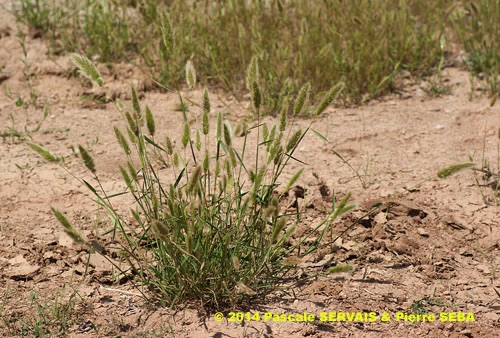
7
Étymologie / Etymology :
Polypogon : emprunt du grec ancien πολύς, πολλή, πολύ (adj.)
= beaucoup + πώγων, -ωνος (nom) = la barbe, en référence à la
panicule velue sur toute sa longueur.
Monspeliensis : emprunt du latin monspeliensis, -is, -e (adj.)
= de Montpellier, qui vient de Montpellier (ville du sud de la France).
Polypogon : borrowed from Classical Greek πολύς, πολλή, πολύ (adj)
= many + πώγων, -ωνος (noun) = beard, referring to the panicle
very hairy over all its length.
Monspeliensis : borrowed from Latin monspeliensis, -is, -e (adj)
= of or from Montpellier (a city in southern France).
Synonymes / Synonyms :
Agrostis alopecuroides Lam.
Agrostis crinita Moench
Agrostis panicea var. major Aiton
Agrostis triaristata Knapp
Alopecurus aristatus Gouan
Alopecurus aristatus var. monspeliensis (L.) Huds.
Alopecurus aristatus var. paniceus (L.) Huds.
Alopecurus monspeliensis L.
Alopecurus paniceus (L.) L.
Cynosurus paniceus L.
Phleum crinitum Schreb.
Phleum monspeliense (L.) Koeler
Polypogon alopecurus Bubani
Polypogon crinitus Nutt.
Polypogon flavescens C.Presl
Polypogon intermedius Guss.
Polypogon maritimus var. paniceus (L.) DC.
Polypogon massiliensis Desf. ex Boisd.
Polypogon monspeliensis var. capensis Steud.
Polypogon monspeliensis var. giganteus Font Quer
Polypogon monspeliensis var. intermedius (Guss.) Nyman
Polypogon monspeliensis var. maximus Lojac.
Polypogon monspeliensis var. pallens Nees
Polypogon monspeliensis var. paniceus (L.) Gray
Polypogon monspeliensis var. polysetus (Steud.) Steud.
Polypogon paniceus (L.) Lag.
Polypogon paniceus var. monspeliensis (L.) Dumort.
Polypogon polysetus Steud.
Santia monspeliensis (L.) Parl.
Santia plumosa Savi
Noms vernaculaires / Common names :
Nom français / French name :
Polypogon de Montpellier.
Noms anglais / English names :
Annual beard-grass — Annual beardgrass —
Annual rabbitsfoot-grass.
Nom allemand / German name :
Gewöhnliches Bürstengras.
Noms espagnols / Spanish names :
Cola de zorra — Pajilla.
Nom italien / Italian name :
Coda di lepre comune.
Habitat :
Lieux incultes - Lieux humides, mares - Sols sableux.
Waste ground - Damp places, ponds - Sandy soils.
Île / Island :
Tilos.
Hauteur / Height range :
De 10 cm à 70 cm.
From 10 cm to 70 cm.
Floraison / Flowering time :
D’avril à juin.
From April to June.
Groupe / Classification :
Monocotylédones.
Monocotyledons.
Pérennité / Lifespan :
Annuelle.
Annual.
Description :
Photo 1 :
Localisation / Location : Tilos, Livadia, Village
Date : 17/05/2014
GPS : Lat. 36,41265° N / Long. 27,38787° E / Alt. 4 m
Type : Photographie numérique / Digital Photograph (10 mégapixels)
Photo 2 :
Localisation / Location : Tilos, Livadia, Village
Date : 17/05/2014
GPS : Lat. 36,41265° N / Long. 27,38787° E / Alt. 4 m
Type : Photographie numérique / Digital Photograph (10 mégapixels)
Photo 3 :
Localisation / Location : Tilos, Livadia, Village
Date : 17/05/2014
GPS : Lat. 36,41265° N / Long. 27,38787° E / Alt. 4 m
Type : Photographie numérique / Digital Photograph (10 mégapixels)
Photo 4 :
Localisation / Location : Tilos, Livadia, Village
Date : 17/05/2014
GPS : Lat. 36,41265° N / Long. 27,38787° E / Alt. 4 m
Type : Photographie numérique / Digital Photograph (10 mégapixels)
Photo 5 :
Localisation / Location : Tilos, Livadia, Village
Date : 17/05/2014
GPS : Lat. 36,41265° N / Long. 27,38787° E / Alt. 4 m
Type : Photographie numérique / Digital Photograph (10 mégapixels)
Photo 6 :
Localisation / Location : Tilos, Livadia, Village
Date : 17/05/2014
GPS : Lat. 36,41265° N / Long. 27,38787° E / Alt. 4 m
Type : Photographie numérique / Digital Photograph (10 mégapixels)
Photo 7 :
Localisation / Location : Tilos, Livadia, Village
Date : 17/05/2014
GPS : Lat. 36,41265° N / Long. 27,38787° E / Alt. 4 m
Type : Photographie numérique / Digital Photograph (10 mégapixels)

Google Maps
Google Maps
Google Maps
Google Maps
Google Maps
Google Maps
Google Maps